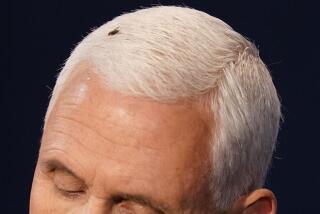Presidential debate rules not exactly what campaigns had in mind
- Share via
It wasn’t quite “Butch Cassidy and the Sundance Kid,” in which Paul Newman’s “Butch” declares the need to “get the rules straightened out” before a knife fight—only to attack his giant adversary with a swift kick in the groin.But the second presidential debate between President Obama and Mitt Romney varied in marked ways from the rules the two campaigns agreed to in advance. The actual rule book for the debates is not in the hands of the candidates but of the sponsoring Commission on Presidential Debates. That 35-year-old group, which describes itself as nonpartisan, did not go along with everything the candidates wanted.
Whether it affected the outcome will be argued until the Nov. 6 election, and beyond. But a 21-page Memorandum of Understanding between the two campaigns makes it clear that what the campaigns agreed to and what they eventually got were two different things.
The long memo, first published by Mark Halperin of Time magazine, laid out the guidelines for each of three presidential debates and one vice presidential debate — down to the right of the candidates to bring their own makeup artists to each session.
PHOTOS: Memorable presidential debate moments
A review of the document shows that where the campaigns’ suggested rules and reality diverged:
NO QUESTIONS TO THE OPPONENT: Rule 5e says, “The candidates may not ask each other direct questions during any of the four debates.” The most notable 5e violations came from Romney early in the debate when he directly faced Obama and asked him — five times in short succession — to say how much he had cut permits “on federal land and federal waters” for fuel extraction. (Obama denied it.)
MODERATOR REMAINS IN BACKGROUND: Section 7 of the agreement specified in various ways that the moderator, Candy Crowley of CNN, was to have minimal direct engagement, beyond asking for questions from the town hall audience. Section 7c(iv) states: “The moderator will not ask follow up questions or comment on either the questions asked by the audience or the answers by the candidates during the debate or otherwise intervene in the debate except to acknowledge the questioners from the audience or enforce the time limits and invite candidate comments during the two minute response period.”
The campaigns raised concerns in advance about Crowley’s role, since she said in interviews she intended to ask followups. But debate co-chairman Frank Fahrenkopf told the Washington Post before the debate that the commission had decided in July that follow-ups would be allowed to “facilitate discussion.”
INTERACTIVE: Battleground states map
Crowley asked plenty of questions and also effectively issued a ruling from the bench when Romney and Obama disagreed about what the president had said about the attack on the U.S. consulate in Libya. The veteran newswoman appeared to side with Obama in saying that the president had said in a Rose Garden speech after the attack that it was “an act of terror.” Obama liked that so much he chimed in: “Can you say that a little louder, Candy?” In a nod to Romney, however, she added that he was “correct” that a series of reports had said (erroneously) that the U.S. personnel in Libya were killed after a riot.
NO TELEVISION SHOTS OF THE OTHER GUY: The commission also obviously decided it wouldn’t live with stipulation 9a(v) between the two campaigns: “To the best of the Commission’s abilities, there will be no TV cutaways to any candidate who is not responding to a question.” Much of the coverage across the TV landscape consisted of split-screen coverage of Romney and Obama.
PERSONAL SPACE VIOLATIONS: Rule 9c(iv) specified that “Each candidate may move about in a pre-designated area, as proposed by the Commission and approved by each campaign, and may not leave that area while the debate is underway. The pre-designated areas of the candidates may not overlap.”
If there were boundaries between Romney and Obama, they were hard to imagine, as the two at times looked ready to chest-up on one another.
So the campaigns didn’t get exactly what they originally hoped for.
TRANSCRIPT: Read Obama, Romney’s arguments
WHAT ABOUT NEXT TIME? For 2016, the debate commission might want to consider a couple of other changes in the town hall format. The rules allowed Crowley to pick the questioners who would get to address the candidates before a national television audience. From an initial pool of about 80 who had been chosen by the Gallup polling organization, just 11 eventually made it on the air.
The rules this time did not allow follow-ups by the voters. But why not let them have a second go at the candidates? The obvious reasons are to keep the debate moving and to prevent the amateur questioners from filibustering.
But would they bog things down any more than the pros? Maybe in the next cycle, the vice presidential candidates could be exposed to follow-ups in the town hall format.
Another improvement might be to have the Gallup (or whatever organization screens the town hall participants) to release the entire list of questions that the participants proposed to ask. The second-guessing of debate moderators will never end. But a little more transparency, next time around, would at least feed a little hard information into the discussion.
Follow Politics Now on Twitter and Facebook
Twitter: @latimesrainey
MORE COMMENTARY FROM JAMES RAINEY:
The main difference in Debate no. 2? Obama punched back
Biden, Ryan debate won’t decide things for either side
Furor over Crowley ignores her record
More to Read
Get the L.A. Times Politics newsletter
Deeply reported insights into legislation, politics and policy from Sacramento, Washington and beyond. In your inbox twice per week.
You may occasionally receive promotional content from the Los Angeles Times.











